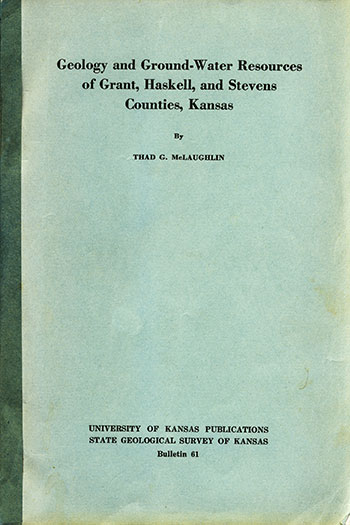Geology and Ground-water Resources of Grant, Haskell, and Stevens Counties, Kansas
by Thad G. McLaughlin

Originally published in 1946 as Kansas Geological Survey Bulletin 61. This is, in general, the original text as reprinted in 1946. The information has not been updated. Also, the photos are not available at this time in this electronic version.
You may also wish to visit our web sites on the Grant, Haskell, and Stevens County geologic maps.
Abstract
The report describes the geography, geology, and ground-water resources of Grant, Haskell, and Stevens Counties in southwestern Kansas. These counties have an area of about 1,881 square miles and had a population of 7,227 in 1940. The area consists predominantly of flat upland plains, which are disrupted only by the valleys of the Cimarron River and its tributaries and by sand hills. The climate is semiarid, the average annual precipitation being about 18 inches. Farming and raising of livestock are the principal occupations in this area. Irrigation has been practiced in several parts of the area and has increased greatly since 1940.
Almost all the exposed rocks in the Grant-Haskell-Stevens area are Pleistocene or Recent. A map showing the areas of outcrop of the rock formations is included in the report. The Meade formation (Pleistocene) and the Kingsdown formation (Pleistocene and Recent) crop out in most of Grant and Haskell Counties and in the northern part of Stevens County, and dune sand is at the surface in much of the remainder of the area. The Tertiary and Quaternary formations contain thick beds of coarse sand and gravel which yield large quantities of water to wells. The report also contains a diagrammatic cross section of the area showing the distribution of the rock formations above the Permian redbeds, as determined by extensive test drilling.
The report contains a map of the area showing by means of shading the depth to water level. The water table ranges in depth from less than 10 feet in parts of the valleys of the Cimarron River and its tributaries to almost 250 feet in the upland area in western Haskell County. A map showing by means of contours the shape and slope of the water table is also included in this report. This map shows that ground water moves eastward through Grant, Haskell, and Stevens Counties, and that the gradient of the water tables ranges from about 5 feet to the mile in eastern Haskell County to about 50 feet to the mile in southeastern Grant County.
The ground-water reservoir is recharged principally from rain and snow that fall within the area, by percolation from intermittent streams and depressions, and by underground movement from adjacent areas. Ground water is discharged from the ground-water reservoir by movement into adjacent areas to the south and east, by evaporation and transpiration in areas of shallow water table, by seepage into perennial streams, and by wells. All of the domestic, stock, public, industrial, and irrigation supplies are obtained from wells.
Most of the wells in this area are drilled, but a few are dug, driven, or bored. Of the 356 wells listed in the report, 20 were used for irrigation when visited. In 1942, they supplied about 3,500 acre-feet of water to irrigate 2,277 acres of land. The areas most favorable for the development of irrigation are in western Grant County, northern Stevens County, and northeastern Haskell County.
The ground water in Grant, Haskell, and Stevens Counties is hard but is suitable for most ordinary uses. Waters from the Pliocene and Pleistocene formations are similar in composition and hardness. Waters from the Recent alluvium generally are very hard.
The principal water-bearing beds in this area are the Pliocene and Pleistocene deposits, including the Laverne, Rexroad (?), and Meade formations. The character and water supply of each formation are discussed in the report.
The field data upon which most of this report is based are given in tables; they include records of 356 wells and chemical analyses of the water from 76 representative wells and from one gravel pit. Logs of 60 test holes, water wells, and oil and gas wells in the area are given, including 46 test holes put down by the State and Federal Geological Surveys.
Kansas Geological Survey, Geohydrology
Web version May 2002. Original publication date July 1946.
Comments to webadmin@kgs.ku.edu
The URL for this page is http://www.kgs.ku.edu/General/Geology/Grant/index.html